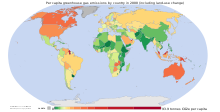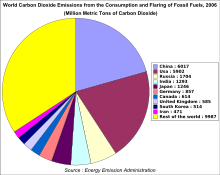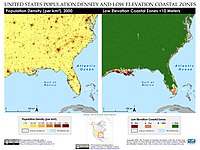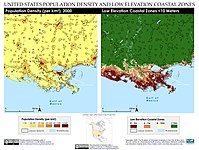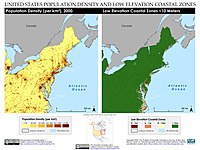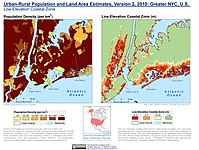Per capita anthropogenic greenhouse gas emissions by country for the year 2000 including land-use change.
Environmental issues in the United States include climate change, energy, species conservation, invasive species, deforestation,
mining, nuclear accidents, pesticides, pollution, waste and
over-population. Despite taking hundreds of measures, the rate of
environmental issues is increasing rapidly instead of reducing.
Movements and ideas
20th century
Both Conservationism and Environmentalism appeared in political debate in forests about the Progressive Era in the early 20th century. There were three main positions. The laissez-faire
position held that owners of private property—including lumber and
mining companies, should be allowed to do anything they wished for their
property.
The Conservationists, led by President Theodore Roosevelt and his close ally Gifford Pinchot,
said that the laissez-faire approach was too wasteful and inefficient.
In any case, they noted, most of the natural resources in the western
states were already owned by the federal government. The best course of
action, they argued, was a long-term plan devised by national experts
to maximize the long-term economic benefits of natural resources.
Environmentalism was the third position, led by John Muir
(1838–1914). Muir's passion for nature made him the most influential
American environmentalist. Muir preached that nature was sacred and
humans are intruders who should look but not develop. He founded the Sierra Club
and remains an icon of the environmentalist movement. He was primarily
responsible for defining the environmentalist position, in the debate
between Conservation and environmentalism.
Environmentalism preached that nature was almost sacred, and that
man was an intruder. It allowed for limited tourism (such as hiking),
but opposed automobiles in national parks. It strenuously opposed timber
cutting on most public lands, and vehemently denounced the dams that
Roosevelt supported for water supplies, electricity and flood control.
Especially controversial was the Hetch Hetchy dam in Yosemite National Park, which Roosevelt approved, and which supplies the water supply of San Francisco.
Climate change
United States projected Köppen climate classification map for 2071 to 2100
The current effects of global warming in the United States are widespread and varied. In 2012, the United States experienced its warmest year on record. As of 2012, the thirteen warmest years for the entire planet have all occurred since 1998, transcending those from 1880. Different regions experience widely different climatic changes. Changes in climate in the regions of the United States appear significant. For example, drought conditions appear to be worsening in the southwest while improving in the northeast. Some research has warned against possible problems due to American climate changes such as the spread of invasive species and possibilities of floods as well as droughts. Climate change is seen as a national security threat to the United States.
The United States is among the most significant emitters of greenhouse gasses in the world. In terms of both total and per capita emissions, it is among the largest contributors.
As of April 2019, 69% of Americans think that climate change is happening and 55% think that it is mostly human caused.
In 2015, according to The New York Times and others, oil companies knew that burning oil and gas could cause global warming since the 1970s but, nonetheless, funded deniers for years. 2016 was a historic year for billion-dollar weather and climate disasters in U.S.
Energy
Satellite image showing the light output at night in the United States
Since about 26% of all types of energy used in the United States are derived from fossil fuel consumption it is closely linked to greenhouse gas
emissions. The energy policy of the United States is determined by
federal, state and local public entities, which address issues of energy
production, distribution, and consumption, such as building codes and
gas mileage advancements. The production and transport of fossil fuels
are also tied to significant environmental issues.
Species conservation
Many plant and animal species became extinct in North America soon after first human arrival, including the North American megafauna; others have become nearly extinct since European settlement, among them the American bison and California condor.
The last of the passenger pigeons
died in 1914 after being the most common bird in North America. They
were killed as both a source of food and because they were a threat to
farming. Saving the bald eagle, the national bird of the U.S., from extinction was a notable conservation success.
As of 13 December, 2016, the International Union for the Conservation of Nature's Red List shows the United States has 1,514 species on its Threatened list (Critically Endangered, Endangered and Vulnerable categories).
Invasive species
Invasive species are a significant problem, some of the most notable
being zebra mussels, Burmese pythons, kudzu, brown tree snakes and
European starlings. Economic damages are estimated at $120 billion per
year.
Deforestation
In 1620
Deforestation in the United States is an ongoing process in the United States. Like Deforestation in the rest of the world, it is a complex environmental issue caused by both social and economic pressures.
Prior to the arrival of European-Americans, about one half of the United States land area was forest, about 1,023,000,000 acres (4,140,000 km2) estimated in 1630. Recently, the Forest Service reported total forestation as 766,000,000 acres (3,100,000 km2) in 2012. The majority of deforestation took place prior to 1910 with the Forest Service reporting the minimum forestation as 721,000,000 acres (2,920,000 km2) around 1920. The forest resources of the United States have remained relatively constant through the 20th century. A 2017 study estimated 3 percent loss of forest between 1992-2001.
The 2005 Food and Agriculture Organization (FAO) Global Forest Resources Assessment ranked the United States as seventh highest country losing its old growth forests, a vast majority of which were removed prior to the 20th century.
Mining
Mining in the United States
has been active since the beginning of colonial times, but became a
major industry in the 19th century with a number of new mineral
discoveries causing a series of mining rushes. In 2015, the value of
coal, metals, and industrial minerals mined in the United States was US
$109.6 billion. 158,000 workers were directly employed by the mining
industry.
The mining industry has a number of impacts on communities, individuals and the environment. Mine safety incidents have been important parts of American occupational safety and health history. Mining has a number of environmental impacts. In the United States, issues like mountaintop removal, and acid mine drainage have widespread impacts on all parts of the environment. As of January 2020. the EPA lists 142 mines in the Superfund program.
The mining industry has a number of impacts on communities, individuals and the environment. Mine safety incidents have been important parts of American occupational safety and health history. Mining has a number of environmental impacts. In the United States, issues like mountaintop removal, and acid mine drainage have widespread impacts on all parts of the environment. As of January 2020. the EPA lists 142 mines in the Superfund program.
Nuclear
The locations across the U.S. where nuclear waste is stored
The most notable accident involving nuclear power in the United States was Three Mile Island accident in 1979. Davis-Besse Nuclear Power Station has been the source of two of the top five most dangerous nuclear incidents in the United States since 1979.
Nuclear safety in the United States is governed by federal regulations and continues to be studied by the Nuclear Regulatory Commission
(NRC). The safety of nuclear plants and materials controlled by the
U.S. government for research and weapons production, as well those
powering naval vessels, is not governed by the NRC.
The anti-nuclear movement in the United States consists of more than eighty anti-nuclear groups which have acted to oppose nuclear power and/or nuclear weapons in the USA. The movement has delayed construction or halted commitments to build some new nuclear plants, and has pressured the Nuclear Regulatory Commission to enforce and strengthen the safety regulations for nuclear power plants. Anti-nuclear campaigns that captured national public attention in the 1970s and 1980s involved the Calvert Cliffs Nuclear Power Plant, Seabrook Station Nuclear Power Plant, Diablo Canyon Power Plant, Shoreham Nuclear Power Plant, and Three Mile Island.
Pesticides
Pesticide use in the United States is predominately by the agricultural sector, which in 2012 comprised 89% of conventional pesticide usage in the United States.
The Federal Insecticide, Fungicide, and Rodenticide Act
(FIFRA) was first passed in 1947, giving the United States Department
of Agriculture responsibility for regulating pesticides. In 1972, FIFRA
underwent a major revision and transferred responsibility of pesticide
regulation to the Environmental Protection Agency and shifted emphasis
to protection of the environment and public health.
Pollution
Pollution from the Exxon Valdez oil spill.
Pollution from U.S. manufacturing has declined massively since 1990 (despite an increase in production). A 2018 study in the American Economic Review found that environmental regulation is the primary driver of the reduction in pollution.
Air pollution
Looking down from the Hollywood Hills, with Griffith Observatory on the hill in the foreground, air pollution is visible in downtown Los Angeles on a late afternoon.
Air pollution is the introduction of chemicals, particulate matter, or biological materials into the atmosphere, causing harm or discomfort to humans or other living organisms, or damaging ecosystems. Air pollution can cause health problems including (but not limited to) infections, behavioral changes, cancer, organ failure, and premature death. These health effects are not equally distributed across the U.S population; there are demographic disparities by race, ethnicity, socioeconomic status, and education. Air pollution has affected the United States since the beginning of the Industrial Revolution.
According to a 2009 report, around "60 percent of Americans live in areas where air pollution has reached unhealthy levels that can make people sick". Analyzing data from 2016–2018, the American Lung Association found major declines in air quality, including increases in ground-level ozone.
In 2016, a study found that levels of nitrogen oxides had plummeted over the previous decade, due to better regulations, economic shifts, and technological innovations. NASA reported a 32% decrease of nitrogen dioxide in New York City and a 42% decrease in Atlanta between the periods of 2005–2007 and 2009–2011.
Water pollution
Topsoil runoff from farm, central Iowa, USA (2011).
Water pollution in the United States is a growing problem that became critical in the 19th century with the development of mechanized agriculture, mining, and industry, although recent regulation has drastically reduced water pollution throughout the nation. Extensive industrialization and rapid urban growth exacerbated water pollution as a lack of regulation allowed for discharges of sewage, toxic chemicals, nutrients and other pollutants into surface water.
In the early 20th century, communities began to install drinking water treatment systems, but control of the principal pollution sources—domestic sewage, industry, and agriculture—was not effectively addressed in the US until the later 20th century.
These pollution sources can affect both groundwater or surface water depending on their mode of contamination, which could include point source, nonpoint source, or transboundary pollution. Multiple incidents such as the Deepwater Horizon oil spill, have left lasting impacts on water quality, ecosystems, and public health in the United States.
Multiple solutions to water pollution in the United States can be implemented to curtail water pollution. This includes municipal wastewater treatment, agricultural and industrial wastewater treatment, erosion and sediment control, and the control of urban runoff. The continued implementation of pollution prevention, control and treatment measures are used to pursue the goal of maintaining water quality within levels specified in federal and state regulations. However, many water bodies across the country continue to violate water quality standards.
Solid waste
At 760 kg per person the United States generates the greatest amount of municipal waste. As of 2017, municipal waste totalled 267.8 million tons in total, or 4.51 pounds per person per day.
Policy
Solid waste policy in the United States
is aimed at developing and implementing proper mechanisms to
effectively manage solid waste. For solid waste policy to be effective,
inputs should come from stakeholders, including citizens, businesses,
community based-organizations, non governmental organizations,
government agencies, universities, and other research organizations.
These inputs form the basis of policy frameworks that influence solid
waste management decisions. In the United States, the Environmental Protection Agency (EPA) regulates household, industrial, manufacturing, and commercial solid and hazardous wastes under the 1976 Resource Conservation and Recovery Act (RCRA). Effective solid waste management is a cooperative effort involving federal, state, regional, and local entities.
Thus, the RCRA's Solid Waste program section D encourages the
environmental departments of each state to develop comprehensive plans
to manage nonhazardous industrial and municipal solid waste.
Electronic waste
Computer monitors being packed for shipping
Electronic waste or e-waste in the United States refers to electronic products that have reached the end of their operable lives, and the United States is beginning to address its waste problems with regulations at a state and federal level. Used electronics are the quickest-growing source of waste and can have serious health impacts. The United States is the world leader in producing the most e-waste, followed closely by China; both countries domestically recycle and export e-waste. Only recently has the United States begun to make an effort to start regulating where e-waste goes and how it is disposed of.
The United States does not have an official federal e-waste regulation system, yet certain states have implemented state regulatory systems. The National Strategy for Electronic Stewardship was co-founded by the Environmental Protection Agency (EPA), the Council on Environmental Quality, and the General Services Administration (GSA), and was introduced in 2011 to focus on federal action to establish electronic stewardship in the United States. E-waste management is critical due to the toxic chemicals present in electronic devices. According to the United States EPA, toxic substances such as lead, mercury, arsenic, and cadmium are often released into the environment and endanger whole communities; these toxic contaminants can have detrimental effects on the health of ecosystems and living organisms. United States e-waste management includes recycling and reuse programs, domestic landfill dumping, and international shipments of domestically produced e-waste. The EPA estimates that in 2009, the United States disposed of 2.37 million tons of e-waste, 25% of which was recycled domestically.
Hazardous waste
A household hazardous waste collection center in Seattle, Washington, U.S.
Under United States environmental policy, hazardous waste is a waste (usually a solid waste) that has the potential to:
- cause, or significantly contribute to an increase in mortality or an increase in serious irreversible, or incapacitating reversible illness; or
- pose a substantial present or potential hazard to human health or the environment when improperly treated, stored, transported, or disposed of, or otherwise managed.
EPA authorizes states to implement the RCRA hazardous waste program. Authorized states must maintain standards that are equivalent to and at least as stringent as the federal program. Implementation of the authorized program usually includes activities such as permitting, corrective action, inspections, monitoring and enforcement.
Population
The total U.S. population crossed the 100 million mark around 1915,
the 200 million mark in 1967, and the 300 million mark in 2006
(estimated on Tuesday, October 17).
The U.S. population more than tripled during the 20th century — a
growth rate of about 1.3 percent a year — from about 76 million in 1900
to 281 million in 2000. This is unlike most European countries, especially Germany, Russia, Italy and Greece, whose populations are slowly declining, and whose fertility rates are below replacement.
Population growth is fastest among minorities, and according to the United States Census Bureau's estimation for 2005, 45% of American children under the age of 5 are minorities. In 2007, the nation’s minority population reached 102.5 million. A year before, the minority population totaled 100.7 million. Hispanic and Latino Americans accounted for almost half (1.4 million) of the national population growth of 2.9 million between July 1, 2005, and July 1, 2006.
Based on a population clock maintained by the U.S. Census Bureau, the current U.S. population, as of 5:55 GMT (EST+5) 27 April 2012 is 316,237,337. A 2004 U.S. Census Bureau report predicted an increase of one third by the year 2050. A subsequent 2008 report projects a population of 439 million, which is a 44% increase from 2008.
Conservation and environmental movement
Today, the organized environmental movement is represented by a wide range of organizations sometimes called non-governmental organizations
or NGOs. These organizations exist on local national and international
scales. Environmental NGOs vary widely in political views and in the
amount they seek to influence the government. The environmental movement
today consists of both large national groups and also many smaller
local groups with local concerns. Some resemble the old U.S.
conservation movement - whose modern expression is the Nature
Conservancy, Audubon Society and National Geographic Society - American
organizations with a worldwide influence.
